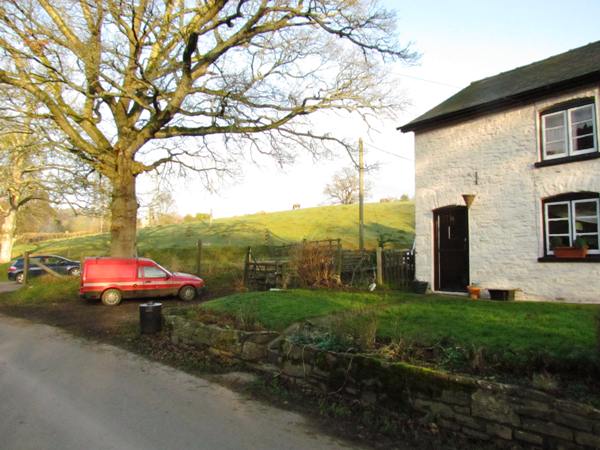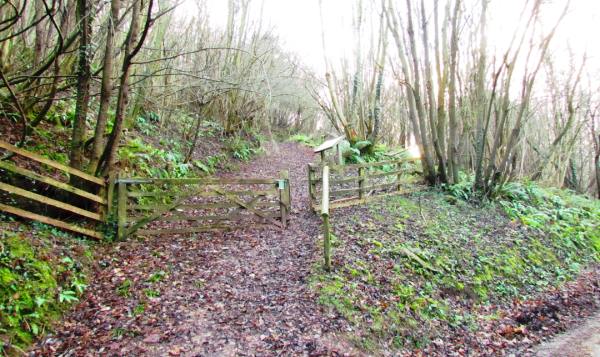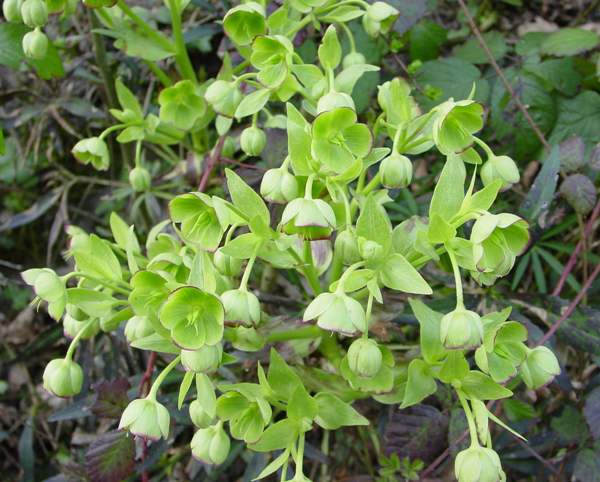Fiddlers Elbow National Nature Reserve and Priory Grove Woodland Trust Reserve, Monmouth
Designations: part of Fiddlers Elbow SSSI and Wye Valley Woodlands/Coetiroedd Dyffryn Gwy SAC
Below: Yellow Archangel is one of the early flowers typical of the broad-leaved woodlands found at Fiddlers Elbow NNR.

Fiddlers Elbow is a fine example of semi-natural broadleaved woodland. The site is situated on a steep-sided slope in the Upper Wye Valley, just over 2km from Monmouth.
Part of the Wye Valley Woodlands SAC, Fiddlers Elbow NNR is part of a cross-border (Wales-England) site comprising of 16 SSSIs, nine of which, including Lady Park Wood which is also a NNR, are inside Wales.
Priory Grove Woodland Trust Reserve is adjacent to Fiddlers Elbow NNR.
The predominant tree species in the woods are Beech, Ash, Lime, Oak and Yew, and the differing soil types found throughout the woodlands contribute to the rich and varied wildlife that is found there.
The management policy of the sites, which includes leaving fallen or standing dead wood in situ, provides ideal habitats for fungi as well as for invertebrates.
The eastern part of Fiddlers Elbow NNR is managed by the Woodlands Trust, Coed Cadw, and the western side is managed in partnership by Natural Resources Wales (NRW) and a private owner.
Directions
Below: The footpath to Fiddlers Elbow Woods is beside this cottage approx. 2km along Hadnock Road

Grid Ref: SO526139
From Monmouth take the main A4136 in an easterly direction (crossing the River Wye) towards Ross-on-Wye.
At the second mini-roundabout turn left into Hadnock Road, which is more or less opposite the MayHill Hotel. Continue along Hadnock Road, which after 1/2km becomes a narrow lane, with the River Wye on your left. About 2km along Hadnock Road you will come to a cottage on the right. Just beyond the cottage, beside an oak tree, there is a finger post pointing off the right-hand side of the road along a footpath signed to Fiddlers Elbow. This path takes you to the western side of the NNR.
There are a number of riverside places to pull in and park along Hadnock Road, including, 1/2km before the cottage and access path to Fiddlers Elbow, an steep entrance into the Woodland Trust nature reserve of Priory Grove Woods - also part of the Wye Valley Woodlands.
Below: The entrance into Priory Grove Woods is directly off Hadnock Road

Alternatively, to gain access to the eastern side of Fiddlers Elbow Woodland NNR, take the A4136 eastwards across the River Wye from Monmouth and continue along the A4136 towards Ross-on-Wye for about 2.5km. The NNR is on either side of this winding road. The entrance to Fiddlers Elbow woodlands from this road is where the Offa's Dyke National Trail crosses the road. There is limited parking in laybys beside this dangerous road.
Access
Footpaths through the woods vary, with some being fairly level and easy-going whilst others require care and can be slippery in wet weather. Good walking shoes or boots are essential.
Facilities
There are no facilities at the reserve. The nearest pubs, shops, cafés and public toilets are in Monmouth, which is about 2km from the reserve.
Description of Site
I have two favourite times of year to visit woodlands such as those at Fiddlers Elbow. The first is in early springtime, when the first flowers are coming into bloom and the small delicate leaves are beginning to colour the trees. The second is in autumn, when the Kingdom of Fungi takes over and amazes me with the shapes and colours of the many mushrooms and other fungal forms that suddenly appear as if from nowhere (or from another planet!).
In spring Fiddlers Elbow is one of the places to enjoy that very British spectacle, Bluebells Hyacynthoides nonscripta. Bluebell woods as we know them occur only in Britain, and we are lucky to have so many marvellous sites where we can enjoy them in Wales. Other lovely spring flowers in this NNR include Primrose Primula vulgaris, Wood Anemone Anemone nemorosa, Ramsons Allium ursinum and Lesser Celandine Ficaria verna, the latter brightening the edge of paths as early as February if we get a few warm and sunny days.
Some of the trees in the area are now rare in the UK, including Large-leaved Lime (Tilia platyphyllos) and two Whitebeams, Sorbus porrigentiformis and Sorbus rupicola. This part of Wales is also the westerly end of the range for Beech trees in Britain, and there are some major Yew tree groves that are also at the most south-westerly edge of their British range.
Below: The exotic bright green, purple-edged flowers of Stinking Hellebore

The variety of woodland types found in this part of Wales is rare elsewhere today, and they support some unusual plants including Narrow-leaved Bittercress Cardamine impatiens, Wood Fescue Festuca altissima, Wood Barley Hordelymus europaeus and Stinking HelleboreHelleborus foetidus.
For wild orchid enthusiasts there are Early Purple Orchids Anacamptis morio, Greater Butterfly-orchids Platanthera chlorantha in the more open grassy parts of the area, and the strange Bird's-nest Orchid Neottia nidus-avis which pops up through the dense leaf litter beneath mature Beech trees in June. At one time the famously elusive Ghost Orchid (Epipogium aphyllum) was recorded from this area, too. As it was rediscovered in the UK in 2011 for the first time in 23 years, anything is possible!
Fiddlers Elbow is also well known for its mammal populations one of which is something of a mixed blessing - the Roe Deer. These lovely creatures are frequently seen in the woods, but they do great damage to young trees making regeneration more difficult. To limit the damage, some parts of the woodland are fenced off to prevent deer from foraging for the precious tree seedlings that must play a vital role in the future of the woodlands.
The other special creature that lives in the woodlands of the Wye Valley is the Dormouse Muscardinus avellanarius, a priority species for the SAC designation of the woodlands as a whole. This delightful little animal feeds on hazel nuts, of which there is a plentiful supply in Fiddlers Elbow Woodlands; it uses the bark of another common tree in the area, Honeysuckle, to build its nest.
Mosses, Liverworts and fungi are very well represented at Fiddlers Elbow and there are some nationally rare species growing there. One of the rare fungi is the Devil's Bolete Rubroboletus satanas for which the Wye Valley ecology is perfect - Beech trees growing on limestone rock. This pored mushroom is easily recognised because it has red pores and a chalky white cap; do not be tempted to eat it because all parts of the fungus are poisonous.